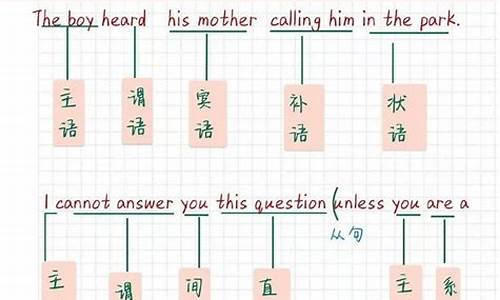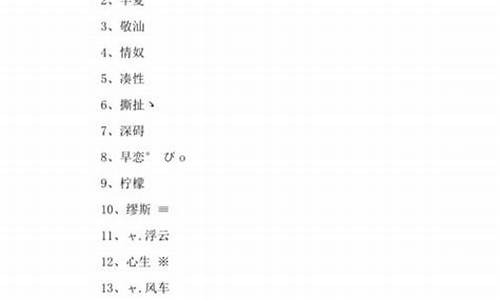您现在的位置是: 首页 > 句子大全 句子大全
_英语句子成分简写
tamoadmin 2024-09-07 人已围观
简介1.英语中介词是什么?2.Is there any bread here为什么不能简写成Is here any bread ?3.不可数名词 简写4.英语单词中介词有哪些5.英语中所有的介词6.英语里的n、adv。prep、v、pron、abbr、adj都代表的是什么词性您好!副词定 义: 副词是一种用来修饰动词,形容词,全句的词,说明时间,地点,程度,方式等概念。分 类: 1) 时间和频度副
1.英语中介词是什么?
2.Is there any bread here为什么不能简写成Is here any bread ?
3.不可数名词 简写
4.英语单词中介词有哪些
5.英语中所有的介词
6.英语里的n、adv。prep、v、pron、abbr、adj都代表的是什么词性

您好!
副词
定 义:
副词是一种用来修饰动词,形容词,全句的词,说明时间,地点,程度,方式等概念。
分 类:
1) 时间和频度副词:
now,then,often,always,usually,early,today, lately, next,last,already,generally,frequently, seldom,ever,never,yet,soon,too, immediately, hardly,finally,shortly, before, ago,sometimes, yesterday.
2) 地点副词:
here, there, everywhere, anywhere, in, out, inside, outside, above, below, down, back, forward, home, upstairs, downstairs, across, along, round , around, near, off, past, up, away, on.
3) 方式副词:
carefully, properly, anxiously, suddenly, normally, fast, well, calmly, politely, proudly, softly, warmly
4) 程度副词:
much,little, very,rather,so,too,still, quite, perfectly, enough, extremely, entirely,almost, slightly.
5) 疑问副词:
how, when, where, why.
6) 关系副词:
when, where, why.
7) 连接副词:
how, when, where, why, whether.
用 法:
副词在句中可作状语,表语,补语。
He works hard.
他工作努力。
You speak English quite well.
你英语讲的很好。
Is she in ?
她在家吗?
Let's be out.
让我们出去吧。
Food here is hard to get.
这儿很难弄到食物。
位 置:
1) 多数副词都可以放在动词的后面,如果动词带有宾语,副词就放在宾语后面。
I get up early in the morning everyday.
我每天早早起床。
He ge me a gift yesterday.
他昨天给了我一件礼物。
She didn't drink water enough.
她没喝够水。
The train goes fast.
火车跑得快。
We can go to this school freely.
我们可以免费到这家学校学习。
They left a life hardly then.
当时他们的生活很艰难。
He has a new hat on today.
他今天戴了一顶新帽子。
I he seen this film twice with my friends.
这部**我和朋友看过两次。
2) 副词修饰形容词,副词时,副词在前面,而被修饰的词在后面。
It's rather easy, I can do it.
这很容易,我能做到。
He did it quite well.
他做得相当好。
It's rather difficult to tell who is right.
很难说谁是对的。
It's so important that I must tell my friends.
这件事太重要了,我得告诉我的朋友。
It's much better.
好多了。
3) 频度副词可放在实义动词的前面,情态动词和助动词的后面。
I often help him these days.
这些日子我经常帮助他。
I always remember the day when I first came
to this school.
我常常记得我第一次来学校的那一天。
You mustn't always help me.
你不能老是帮助我。
He seldom comes to see us.
他很少来看我们。
We usually go shopping once a week.
我们通常一周买一次东西。
The new students don't always go to dance.
新学生并不时常去跳舞。
4) 疑问副词,连接副词,关系副词以及修饰整个句子的副词,通常放在句子或从句的前面。
When do you study everyday?
你每天什么时间学习?
Can you tell me how you did it?
你能告诉我你如何做的吗?
First, let me ask you some questions.
先让我来问几个问题。
How much does this bike cost?
这辆车子多少钱?
Either you go or he comes.
不是你去就是他来。
The students were reading when the teacher came into the classroom.
当老师进教室时,学生们正在读书。
5) 时间副词和地点副词在一个句中, 地点副词在前面时间副词在后面。
We went shopping in the supermarket at 9 o'clock yesterday.
昨天九点钟我们到超市买东西了.
What were you doing in the classroom yesterday afternoon?
昨天下午你在教室里干什么?
The accident took place in the Eleven Avenue one hour ago.
一小时前十一号大街发生了一场事故。
比较等级:
副词和形容词一样,也有它的比较级和最高级形式. 可以参考形容词的变换形式。但以词尾 -ly 结尾的副词(除 early )须用 more 和 most 。
hard harder hardest
fast faster fastest
early earlier earliest
much more most
warmly more warmly most warmly
单音节副词的比较级是在副词后面加上 -er 构成的,最高级是在副词后面加上 -est 构成的。
near nearer nearest
hard harder hardest
多音节副词的比较级是在副词的前面加上 -more 构成的。 最高级是在副词前面加上 -most 构成的。
warmly more warmly most warmly
successfully more successfully most successfully
有些副词的比较级和最高级形式是不规则的。
well-better - best little - less - least
Much- more - most badly - worse - worst
far-farther(further)-farthest(furthest)
副词的比较级和最高级用法同形容词的比较级用法基本一样。 最高级形式句中 the 可以省略。
He works harder than I.
他比我工作努力。
Lucy gets up earlier than Lili.
露西比丽丽起床早。
He runs fastest in our class.
他在我们班跑地最快。
He dives deeper than his teammates.
他比他的队员潜水深。
It's true that he speak English more fluently than any of us.
他英语讲的确实比我们任何人都好。
Our school team play football best in our region.
我们校队在我们地区足球踢得最好的。
副词比较级和最高级的形式
副词比较级和最高级的变化形式与形容词基本上一样
一般 副词
hard→harder →hardest
fast→faster →fastest
late→later →latest
early→earlier →earliest
特殊 副词
well →better →best
much →more →most
badly →worse →worst
little →less →least 但是,开放类副词即以后缀?ly结尾的副词不能像形容词那样加?er或?est,如
quickly →more quickly →most quickly quietly →more quietly →most quietly
〔注〕: early与slowly中的?ly不是后缀,故可以把?y变?i再加?er和?est
比较级和最高级的基本用法
一、原级比较的基本用法
1. 原级比较由“as+形容词或副词(或再加名词或短语)+as ”构成“原级相同”比较句,表示两者比较;其否定式,即“程度不及”比较句型为“not so(as) +形容词或副词+as”,而且as…as结构前可用just, almost, nearly, quite等表示程度的词修饰
1) Walking briskly for thirty minutes will burn as many calories as .
〔A〕 to run for fif minutes
〔B〕 running for fif minutes
〔C〕 you run for fif minutes
〔D〕 fif?minute walking
2) The gorilla(大猩猩), while 〔A〕 not quite as curious than 〔B〕 the chimpanzee(黑猩猩), shows more persistence 〔C〕 and memory retention(记忆力) in solving 〔D〕 a problem.
3) Alaska is twice 〔A〕 as larger 〔B〕 as 〔C〕 the next largest 〔D〕 state, Texas.
2. “as (so)+名词+as+名词”进行名词比较,这时一般情况下有一个表示原级的比较词,但如果第一名词前出现了形容词修饰该词或出现副词修饰谓语,应当用so而不用as
4) Thomas Jefferson’s achievements as an architect rival his contributions a politician.
〔A〕 such
〔B〕 more
〔C〕 as
〔D〕 than
5) I should say Henry is not much a writer as a reporter. (88年考题)
〔A〕 that
〔B〕 so
〔C〕 this
〔D〕 as
二、比较级
1. 比较级由“形容词(副词)比较级+than+…,”构成表示在两者中间一方比另一方“更加…”。连词than后可接句子,也可接名词、代词、名词短语、介词短语、动词、动词不定式、?ING结构和?ED结构,有时也可省去than。
6) Natural mica(云母) of 〔A〕 a superior 〔B〕 quality is cheapest 〔C〕 to oain than synthetic 〔D〕 mica.
7) She is older than .
〔A〕 any other girl in the group
〔B〕 any girl in the group
〔C〕 all girls in the group
〔D〕 you and me as well as the group
8) Josephine McCrackin joined 〔A〕 the “Santa Cruz Sentinel” in 1905 and, until her death fif years late 〔B〕 , remained 〔C〕 active in journalistic 〔D〕 work.
2. 注意than前后两项相比较的人或事物要一致
9) The purpose of the research had a more important meaning for them than .
〔A〕 ours
〔B〕 with us
〔C〕 for ours it had
〔D〕 it did for us
10) Sound trels air.
〔A〕 faster through water than through 〔B〕 faster than through water and
〔C〕 through water faster and〔D〕 where it is faster through water than through
11) Gerbrand von den Feckhout, one of Rembrand’s pupils, followed 〔A〕 the style of his teacher so implicitly that 〔B〕 his paintings 〔C〕 are sometimes confused with his master 〔D〕 .
三、最高级
1. 最高级用于三者以上比较,形容词的结构形式是“定冠词+形容词最高级+名词+表示范围的短语或从句”(如all, of all, of the tree, in the world, that has ever taken place等)
12) The more 〔A〕 fearsome of all the 〔B〕 animals in 〔C〕 the Western 〔D〕 Hemisphere is the grizzly bear.
13) Of all economic 〔A〕 problems, inflation continues to be 〔B〕 a 〔C〕 most significant in its daily impact on 〔D〕 people and business.
14) , the most familiar to general public is the criminal jurisdiction.
〔A〕 All the activities
〔B〕 The activities
〔C〕 Of all the activities
〔D〕 It is the activities
2. 副词的最高级与形容词最高级的区别在于最高级前没有定冠词the
[编辑本段]例题解析
1) B为正确答案。
2) B错。改为 as ,和前面的as和形容词原形curious 一起构成同程度比较。
3) B错。 改为as large。
4) C对。动词rival(胜过、匹敌)前后是两个相比较的成分achievements(成果)和 contributions(贡献),由于前面的名词后出现了短语 as an architect,故空白处也应用as,使前后对比成分一致。
5) B为正确答案。
6) C错。应改为比较级cheaper。比较级后并不一定跟接连词than,有时在其间有名词或名词短语(被形容词所修饰),介词短语,不定式或其他成分隔开。
7) A为正确答案。“She”作为单个不能跟全组比(C和D不对),也不能跟全组所有相比,因为“她”也是其中一员,自然“她”不能跟自己相比。这里“She”比较的是“这组中的任何一个”,所以A对。
8) B错。应改为比较级later,因此处实为与1905年相比晚15年,故应使用比较级。
9) D为正确答案。
10) A为正确答案。
11) D错。 改为his master’s。
12) A错。 改为most。
13) C错。改为the, significant是多音节形容词,在此处应用最高级形式(在前面加 the most),注意句中的“of all… ”。
14) C为正确答案。本句空白处缺状语,A和B全为名词短语,不符合条件;D为句子,和空白后面的句子没有任何联系,故亦应排除。只有C正确,和后面的最高级the most familiar前后呼应。
[编辑本段]特殊表达法
一、形容词与副词的同级比较: 由“as(so)…as”引出,其否定式为“not so…”或“not as…as”,考生还应注意下列含有“as”结构或短语的句子
1. as such:表示上文所指明的事或人
He is a child,and must be treated as such. 他是个孩子,必须被当作孩子对待。
2. as much:表示“与…同量”
Take as much as you like. 拿多少都行。
I would gladly he paid twice as much for it. 就是价格再贵一倍,我也会愿意把它买下的。
He as much as admitted the whole story. 他几乎全部承认了。
3. as many:表示“与…一样多”
I found six mistakes in as many lines. 我在六行中发现了六个错。
二、表示“几倍于”的比较级:用twice (两倍),four times (四倍),ten times (十倍)加上as … as 结构
This one is four times as big as that one. 这个是那个的四倍大。(这个比那个大三倍。) / Our campus is three times as large as yours. 我们的校园比你们的大两倍。 / He has books twice as many as she does. 他的书比她多一倍。
1) The five?year deal obligates 〔A〕 the country to buy nine million tons 〔B〕 of grain a year 〔C〕 , three million more as 〔D〕 the old pact’s minimum.
三、“the same +名词+as”表示同等比较
2) The lens of a camera performs the lens of the eye.
〔A〕 in the same function 〔B〕 the same function as
〔C〕 the function is the same as 〔D〕 and has the same function
3) The elimination of inflation would ensure that the amount of money used in repaying a loan would
he as the amount of money borrowed.
〔A〕 as the same value 〔B〕 the same value
〔C〕 value as the same 〔D〕 the value is the same
四、比较级前可用a little, a bit, slightly, a great deal, a lot,many, much等词语表示不定量,far, completely,still表示程度或更进一步
4) There are now methods for studying color vision in infants than there once were.
〔A〕 more sophisticated than
〔B〕 much more sophisticated
〔C〕 much sophisticated
〔D〕 sophisticated
5) The photographs of Mars taken by satellite are than those taken from the Earth.
〔A〕 clearest
〔B〕 the clearest
〔C〕 much clearer
〔D〕 more clearer
6) Common porpoises(海豚) are usually not considered 〔A〕 migratory, although 〔B〕 some do move 〔C〕 to more warmer 〔D〕 waters in winter.
兼有两种形式的副词
1) close与closely
close意思是"近"; closely 意思是"仔细地"
He is sitting close to me.
Watch him closely.
2) late 与lately
late意思是"晚"; lately 意思是"最近"
You he come too late.
What he you been doing lately?
3) deep与deeply
deep意思是"深",表示空间深度;deeply时常表示感情上的深度,"深深地"
He pushed the stick deep into the mud.
Even father was deeply moved by the film.
4) high与highly
high表示空间高度;highly表示程度,相当于much
The plane was flying high.
I think highly of your opinion.
5) wide与widely
wide表示空间宽度;widely意思是"广泛地","在许多地方"
He opened the door wide.
English is widely used in the world.
6) free与freely
free的意思是"免费";freely 的意思是"无限制地"
You can eat free in my restaurant whenever you like.
You may speak freely; say what you like.
副词有加a或ly的 区别在于通常加a 的副词描述一种状态,而加ly 的副词则倾向于感觉。
可修饰比较级的词
1)a bit, a little, rather, much, far, by far, many, a lot, lots, a great deal, any, still, even等
2)还可以用表示倍数的词或度量名词作修饰语。
3)以上词(除by far)外,必须置于比较级形容词或副词的前面。
典型例题:
1) ---- Are you feeling ____?
---- Yes,I'm fine now.
A. any well B. any better C. quite good
D. quite better
答案:B. any 可修饰比较级,quite修饰原级,well的比较级为better.
2)The experiment was____ easier than we had expected.
A. more B. much more C. much
D. more much
答案:C. much可修饰比较级,因此B,C都说得通,但easier本身已是比较级,不需more,因此C为正确答案。
3)If there were no examinations, we should he ___ at school.
A. the hiest time B. a more hier time
C. much hiest time D. a much hier time
答案:D。
中国语文中的副词
副词是一类用以修饰名词以外词语和整个句子的词,修饰名词的词一般为形容词。
一般而言中文在一个词的后面加「的」使其成形容词,加「地」使其成副词,但是现在一般已经不太常做这种区别了。
以副词修饰的句子举例:「一只非常小的虫轻易地钻进了那个洞穴里」,其中[非常]和[轻易]地为副词,小为形容词,虫为主词,钻进为动词,洞穴里指明前往地点。
一些问问题时的所用的词,像如何、谁、何时、什么等在某方面也可视为副词。
副词口诀:
副词修饰动与形,范围程度与时间。肯否估计与情态,语气频率用法全。
稍微没有全都偏,简直仅仅只永远,已经曾经就竟然,将要立刻刚偶然,
渐渐终于决忽然,难道连续又再三,也许必须很非常,最太十分更马上,
越极总挺常常再,屡次一定也不还。时名副名看加在,名前可加副不来。
前很后名都不行,单独回答更不能。
英语中介词是什么?
副词主要用来修饰动词,形容词,副词或其他结构。
一、副词的位置:
1) 在动词之前。
2) 在be动词、助动词之后。
3) 多个助动词时,副词一般放在第一个助动词后。
介词是一种用来表示词与词、词与句之间的关系的虚词,在句中不能单独作句子成分。介词后面一般有名词代词或相当于名词的其他词类,短语或从句作它的宾语。介词和它的宾语构成介词词组,在句中作状语,表语,补语或介词宾语。介词可以分为时间介词、地点介词、方式介词、原因介词和其他介词。
介词口诀:自从以当为按照,由于对于为了到;和跟把比在关于,除了同对向往朝;用在名词代词前,修饰动形要记牢。
1.表示地点位置的介词
1)at ,in, on, to,for
at (1)表示在小地方; (2)表示“在……附近,旁边”
in (1)表示 在大地方; (2)表示“在…范围之内”。
on 表示毗邻,接壤,“在……上面”。
to 表示在……范围外,不强调是否接壤;或“到……”
2)above, over, on 在……上
above 指在……上方,不强调是否垂直,与 below相对;
over指垂直的上方,与under相对,但over与物体有一定的空间,不直接接触。
on表示某物体上面并与之接触。
The bird is flying above my head.
There is a bridge over the river.
He put his watch on the desk.
3)below, under 在……下面
under表示在…正下方
below表示在……下,不一定在正下方
There is a cat under the table.
Please write your name below the line.
4)in front [frant]of, in the front of在……前面
in front of…意思是“在……前面”,指甲物在乙物之前,两者互不包括;其反义词是behind(在……的后面)。
There are some flowers in front of the house.(房子前面有些花卉。)
in the front of 意思是“在…..的前部”,即甲物在乙物的内部.反义词是at the back of…(在……范围内的后部)。
There is a blackboard in the front of our classroom.
我们的教室前边有一块黑板。
Our teacher stands in the front of the classroom.
我们的老师站在教室前.(老师在教室里)
5)beside,behind
beside 表示在……旁边
behind 表示在……后面
[编辑本段]
2.表示时间的介词
1)in , on,at 在……时
in表示较长时间,如世纪、朝代、时代、年、季节、月及一般(非特指)的早、中、晚等。
如 in the 20th century, in the 1950s, in 1989, in summer, in January, in the morning, in one’s life , in one’s thirties等。
on表示具体某一天及其早、中、晚。
如on May 1st, on Monday, on New Year’s Day, on a cold night in January, on a fine morning, on Sunday afternoon等。
at表示某一时刻或较短暂的时间,或泛指圣诞节,复活节等。
如at 3:20, at this time of year, at the beginning of, at the end of …, at the age of …, at Christmas, at night, at noon, at this moment等。
注意:在last, next, this, that, some, every 等词之前一律不用介词。如:We meet every day.
2)in, after 在……之后
“in +段时间”表示将来的一段时间以后;
“after+段时间”表示过去的一段时间以后;
“after+将来的时间点”表示将来的某一时刻以后。
3)from, since 自从……
from仅说明什么时候开始,不说明某动作或情况持续多久;
since表示某动作或情况持续至说话时刻,通常与完成时连用。since表示"自(某具体时间)以来",常用作完成时态谓语
的时间状语。
since liberation(1980)自从解放(1980年)以来 They he been close fr
Is there any bread here为什么不能简写成Is here any bread ?
我不知道你现在的文化程度如何,也不知道你的目的是什么,只好简要的说一下:
介词一般用在人称代词宾语和动词ing前面,常用的介词有:
about关于,after 在……之后,along 沿着,among 在……中间,another 另一个,as 作为/当作,before 在……之前,behind 在……后面,below 在……下面,beside (next to ) 在……旁边,between 在……之间,by 在……旁边/被/乘/用/到……为止,down 沿着(街道、河流)而下/,during 在……期间,for 往/为了/的/达,from 从/自……起/距/来自
等等。
不可数名词 简写
第一句是英语中的一个常用句式 there be 结构句式, 表示有 。there be 结构才用倒装形式。
There is some bread here. Is there any bread here ?
Is here any bread ? 是错句, here 是副词, 不能作主语, 故不能把is 放在 here 前面表示疑问句。
英语单词中介词有哪些
可数名词countablenoun,常用缩写为cn。不可数名词uncountablenone常用缩写为un。
可数名词缩写为:C,英文为:countablenoun。不可数名词的缩写为:U,英文为:Uncountablenoun。
可数名词是指能以数目来计算,可以分成个体的人或东西,且可直接用数目进行计数的名词。
可数名词是指不能以数目来计算,不可以分成个体的概念、状态、品质、感情或表示物质材料的东西;它一般没有复数形式,只有单数形式,它的前面不能用不定冠词a/an,若要表示它的个体意义时,一般要与一个名词短语连用,相当于中文里的数词+(量词)+名词,其中的量词意义依与具体的名词搭配而定。一站式出国留学攻略 ://.offercoming
英语中所有的介词
1、according to,by,from,on,under等。
这组词的共同意思是“根据”“按照”;
①according to是这组词中最常用的一个,可指依据某人的话语、说法、指示,也可指按照某、法规等,可以是正式的,也可以是非正式的。
②by的本意是“凭借某种手段、方式”,由此引申出“依据,按照”,其宾语常为某种规则、法规、标准、习俗等。
③from的本意是“来源”,由此引申出“根据事物的来源判断”。
④in指“依据”时,仅见于与eye,opinion,view等表示观点的名词或order,sequence等表示顺序的名词连用,还见于in law,in practice,in theory等短语中。
⑤on是根据事物发生和存在所依靠的基础这一用法,由此引申为“根据,按照”,与之连用的词一般是表示忠告、规则、命令、指示、协议、建议、原理的名词。
⑥under通常指根据正式的协议、法令、条款、合同等,含有在其控制或约束之下的意味。
2、in, after, since等。
这三个介词都可指示时间关系,表示“在…之后”;
①after可表示从过去时间算起的一段时间之后,往往与过去时态连用(若接表示时间点的词,也可与将来时态连用)。
②in则表示从现在时间算起,推移到将来的一段时间之后,一般与将来时态连用。
③since所表示的时间,往往是从过去某一点时间一直延续到说话的时间,因而一般与完成时态连用。
扩展资料;
1、after可用作连词连接一个时间状语从句,从句中一般用现在时表示将来。
2、after用作副词时常与soon,ever搭配,通常用于表示时间的名词后。
after用作副词时不用于比较等级。
注意after和in的使用:从某时说到多少时间以后,不用after,而用in。如果指“某个时刻,日期或以后”,用after。
3、表达“某的若干时间以后”时,应是“若干时间after”,而不是“after若干时间of”。可说two hours?after?his arrival,不可说after?two hours of his arrival。
在“two hours?after?his arrival”前加不同的介词,有不同的意思:“two hours?after?his arrival”单用时指“他到达两小时以后”。
4、若前面加the,如the two hours?after?his arrival指“他到达以后的两小时”,加for指“在他到达以后的两小时全段时间里”,加in 跟没有in意思相同,加within指“在他到达以后的两小时中的某时刻”。
5、指“若干时间after日期或月份”时,常把当天的日期或当月除外。
如five days?after?3 July,指从7月4日算起的5天以后,也就是7月9日。
但有例外,five days?after?I July可能指7月8日,months?after?July可能指11月,注意避免这种结构产生误解。
6、指“从过去的某时或某事说到现在”时,不用after,用since。
所以可说Since his graduation he has been abroad.(since不可改成after)一定要改的话,可表示为After his graduation he went abroad. 这里的after是介词,用作连接词时用法一样。
7、after引导的状语从句,用现在时态,不用将来时态。
after常指时间先后的次序,而behind常指位置,如August comes?after?July,用after,,而A garden lies behind the house,用behind。不过有时after和behind可以通用。
英语里的n、adv。prep、v、pron、abbr、adj都代表的是什么词性
英语介词有:in、on、for、at、about
一、at的用法:
1.用于地方时,at指较小的地方,如指城镇时。
2.商店、机关、学校等,使看作一个地点(point)用at。使看作一个场所(place)用in,the barber's (理发店),Green's (Green所开的店)等前面只用at。
二、about的用法:
1.在指“不久就要……”时,后通常接不定式,如about?to start。
2.接动名词,如about?starting。但是不可再加表示时间的词,如不可说about?starting at once。
三、in的用法:
1.in用在一些动词、名词、形容词后面,以引出附加信息。in 还与表示动作的动词连用,如 walk,push等,还用在诸如 give in,dig in 等短语动词中。
2.in作介词在句中弱读,作副词在句中重读。指能用in的表达方式有in the morning,in the afternoon,in the evening。
四、on的用法:
日期前的on常被省略。表示“手脚上的斑点”时,应用介词on;on?the river在不同意境下,意思不同。
五、for的用法:
for是并列连词,引导的是并列从句,表示原因的语气很弱,一般是对结果作出推断性的补充说明或解释,不表示直接原因,?for前多加逗号。
扩展资料介词定义:
介词在语法里是一个用来表现一个字的文法功能的词汇或字缀。一般用在名词,代词或名词性质的短语前面,和这些词合起来组成介词结构,以表示所处、时间、状态、方式、原因、目的、比较对象等的词。
介词用法:
介词一般用于名词或者代词前面,表示该词与句中其他成分的关系。介词后面的名词或代词称为介词宾语(如果是人称代词,则要用宾格)。介词和介词宾语合在一起构成介词短语。
介词是一种虚词,不能单独作句子成分,只能用在一个名词、代词或相当于名词的结构之前,可以与后面的词一起构成介词短语。
英语里的n、adv、prep、v、pron、abbr、adj代表的词性是:n 名词;adv 副词;prep 介词;v 动词;pron 代词;abbr 缩写;adj 形容词。
分享免费试听课地址:s://.acadsoc点击即可领取专属欧美外教一对一免费试听课!
阿卡索是固定外教1对1课上精讲,用深度惯性学习法打造‘25+N’ 循环沉浸式课程。英语课程拥有较高的性价比,每节课不超过20元。
希望可以帮到你啦!
想要找到合适英语培训机构,百度搜下“阿卡索vivi老师”即可。
百度搜下“阿卡索论坛”免费获取全网最齐全的英语。
下一篇:很伤感很丧的句子_伤感很丧的说说









